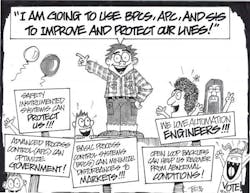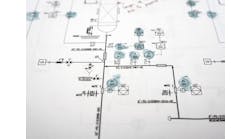Greg: I learned early in my career that compressor surge is the fastest phenomenon that occurs in process industries around turbomachinery, and with the most disastrous consequences. We had huge axial air compressors whose acceleration upon surge during tests was measured to be 2,000 rpm/sec from the unloading during flow reversal. We used a derivative module to trip the compressor in less than a second. While this compressor was undoubtedly special, the fact remains that when a compressor goes into surge, the compressor flow can reverse direction in less than 0.02 seconds. It’s like running up a hill and just as you get to the top, you come to a cliff, can’t stop in time and go over the edge.
This corresponds to an operating point moving up the compressor characteristic curve to the point of maximum pressure rise, then coming to a sudden reversal in the sign of the slope of the characteristic. Not typically shown on compressor maps is that the slope of the performance curve becomes positive after reaching a maximum, so that as the flow decreases, the pressure rise from suction to discharge also decreases, creating positive feedback.
Another factor contributing to developing surge is the rotating stall phenomenon, which can push the operating point into full surge. The overall result is that the operation of the compressor becomes unstable, with self-sustaining oscillations, as the operating point jumps to a negative flow region, then rapidly recovers as the pressure ratio across the compressor drops. The surge cycle then repeats itself. The surge cycle period varies from about 0.1 seconds in benchtop tests of laboratory-scale units to about 1-3 seconds in large industrial installations. My book, "Centrifugal and Axial Compressor Control," reveals the path of the operating point on the unseen compressor map to the left of the surge curve and the resulting oscillations in suction flow and discharge pressure, as well as the dynamic model that will show this behavior. Naum Staroselsky was the person who triggered many of my thoughts and was the ultimate expert in my book, literally and figuratively, as exemplified by his article “Improved Surge Control for Centrifugal Compressors,” Chemical Engineering, May 1979.
Stan: Naum Staroselsky was the first person to emphasize the precipitous drop in flow during surge, the exceptional requirements as to how fast the automation control system needed to respond, and that feedback control by itself often could not get a system out of surge because the oscillations were so severe and fast.
Greg: I had the privilege of talking with Naum several times back in the 1980s. He developed the essential speed-of-response requirements of each component in the system, as well as algorithms for dealing with these fast transients. He also implemented strategies for compressors operating in series to increase the total pressure rise and in parallel to increase the total flow capacity. Here we have the opportunity to get a review and update with Naum’s son, Serge Staroselsky, who is the chief technical officer for Compressor Controls Corporation.
Stan: Which types of compressors have the most severe surge cycles and damage?
Serge: Axial compressors are more susceptible to damage due to their design. The issue of protection from damage caused by surge has always been very important to anyone operating turbomachinery. Emphasizing this point, the latest edition of API Standard 670, “Machinery Protection Systems” (5th Edition), has a dedicated section on surge protection, which mandates a separate surge detector for axial compressors and recommends segregated detection for critical centrifugal machines deemed susceptible to surge damage, such as compressors operating at very high pressures (e.g., reinjection service). If you have a redundant system, you can integrate the detector into the compressor control system, but the preference is for a segregated system. The detection system protects the compressor, in case the primary antisurge system fails to do so, by either opening the antisurge valve via a trip solenoid, actually tripping the unit, or both.
Almost every compressor will eventually suffer damage from excessive surge cycles. In most cases, it’s continuous rather than individual surge cycles that cause mechanical damage. Our recommendation is to always prevent three or more successive surge cycles in the time period on the order of 10 seconds, whereas the guidelines by some manufacturers may be more conservative, and use three or more surge cycles in a time period as long as half an hour. In many cases, even if there's no damage to the compressor due to surge, there is a severe process upset that may lead to lost production. The financial implications increase if you're talking about more than one surge cycle, since the process may not be able to recover, resulting in equipment tripping and a subsequent lengthy startup period.
Greg: I once heard that there is a loss in efficiency for each surge cycle, albeit quite small for a single cycle. What do you see as a loss in efficiency from surge?
Serge: I have not seen much data on this. We'll be offering performance monitoring software that includes the ability to calculate the efficiency online, which will allow us to evaluate the loss of performance over time.
To do this, you need to know gas composition and use real gas equations; otherwise, the monitoring system can’t provide sufficient reliability. For many compressors experiencing wear-and-tear due to surging for several years, the performance curves (compressor pressure rise versus suction flow curves for various speeds) tend to move down and to the left, indicating internal recirculation. The compressor produces a lower pressure at the same flow. Of course, continuous and frequent surging can result in loss of performance within weeks or even days; it just depends on how often the machine surges and for how long.
Surge causes high radial vibration and high dynamic axial thrust forces. Radial vibration can damage the journal bearing due to breakdown of the flow pattern around the impeller, causing unbalanced aerodynamic forces acting on the rotor and moving it relative to the radial bearing. Surge cycles cause changes in the direction of the flow, and therefore result in rapidly changing axial forces that can damage the thrust bearing due to axial movement of the rotor beyond design tolerances. Changing forces also adversely affect the tight clearances and inter-stage seals in a typical multi-wheel machine, which are designed to prevent backward flow. The result is internal recirculation of flow from the compressor discharge to suction during normal operation and a subsequent loss in efficiency and machine capacity.
While the loss in efficiency after a single cycle may be too small to measure, the ability to trend the cumulative effect of surging and degradation due to fouling and other causes can be useful in scheduling maintenance and in educating us on the importance of proper surge control, providing justification for better control system design, implementation and maintenance.
Stan: How do you get an accurate surge curve?
Serge: Our engineers start with the performance curves from the original equipment manufacturer (OEM) of the compressor. It's critical that we have a flow measurement with good accuracy and repeatability. A venturi tube can provide an excellent low-loss measurement of compressor flow given sufficient straight runs of pipe. Orifice plates, V-cones, and Lo-loss tubes also can provide sufficiently accurate and reliable flow measurement, provided they're installed following good engineering practices.
We highly recommend testing the compressor in the field. The differences between field and shop surge curves can be greater than 10% due to inherent flow measurement inaccuracies, as well as uncertainty in the pressure and temperature measurements at different operating conditions, and limitations in the accuracy of the off-design performance predictions of the OEM.
In some cases, typically for axial compressors and very large, new centrifugal machines, the OEM or the end user may opt out of doing field testing for surge due to the perceived risk. In this case, we recommend at least reducing the flow to 10-12% above the expected surge flow to prove that surging doesn't occur within the expected operating envelope of the machine. We have a technique to detect the start of surge and recover within one cycle, which in a great majority of cases is not dangerous for the machine. An additional benefit of doing tests to identify the surge limit is verification of the ability of the control system to provide a fast and complete recovery.
Before we even do a surge test, we test for proper response of the overall system, which includes the antisurge valve and the compressor with associated vessels and piping. After generating a step command, you should be able to see a discernable change in compressor flow within 1 second from a change in the command signal to the antisurge valve for the system to be fast enough to take the machine out of surge within a single cycle.
We like to do three surge tests at different operating conditions to build the surge limit curve. If there's a major discrepancy between field and OEM curves, we try to find out why. Maybe the conversion of the square root of the differential pressure (dP) signal to flow is incorrect or there is a measurement error. Our new diagnostic system will provide an indication of whether the operating point matches expected performance and, in case of mismatch, indicate probable causes, such as measurement error. In any case, we report any discrepancies to the user and OEM, and work with them to identify the causes.
We try to make our recommendations regarding proper selection and installation of instrumentation as early as possible. In many retrofit jobs, we do a site walk through the existing installation before even starting the design of the surge control system. Sometimes, there are obvious problems with the dP impulse lines, such as accumulation of condensation in the lines from pockets and lack of slope. There may be excessive length due to the desire to make the location of the dP convenient for maintenance. The length from dP transmitter to process connections should not be greater than 10 feet to keep the delay less than 0.1 sec for pressure changes to be sensed in the transmitter. To measure compressor pressure rise, the pressure connections should be close to the inlet and outlet flanges of the compressor. It's surprising how often good engineering practices are not followed, creating excessive delay, noise and erratic behavior in the measurements.
Greg: How fast do the surge valves and measurements need to be?
Serge: The surge valve 95% response time (T95) for a full-scale signal to positioner must be less than 2.5 sec. The time to go from closed to completely open upon de-energizing a solenoid valve must be less than 1 sec. The hysteresis plus dead band must be less than 1%. The maximum control signal needed to initiate movement when the valve is closed must be less than 3%. Stick-slip must be negligible after initial opening for a signal ramping at 0.3%/sec. It's important to do small-step as well as the large-step tests.
We have an algorithm that will step the demand signal by a configurable amplitude, usually around 3%, when the surge valve is asked to open from fully closed position in order to minimize delays due to pressure saturation in the actuator, as well as seat and seal friction. When operating the valve at some intermediate position, we have a feature that mitigates backlash and positioner or actuator resolution and sensitivity limitations.
The 63% response time (pure delay + time constant) (T63) for the dP transmitters should be less than 0.2 sec., and preferably around 100 ms. Many leading manufacturers have a version that will comply. Damping settings must be removed or set to a minimum. Any needed filtering is best done in the controller. There are always pulsations in the flow measurement. At least 0.1 sec. filter time constant is often needed. Sometimes noisier flows require a larger filter, but we generally do not want to go higher than 0.3 sec. This is one of the most painful issues in the field. Fortunately, the compressor discharge and suction pressure measurements are generally not noisy unless the suction pressure is very close to atmospheric.
Stan: How do you handle multiple-stage compressors with recycle streams?
Serge: We see all flavors of compressor arrangements and design of recycle streams. We work with the end user and apply our own experience to determine the main process variable that needs to be maintained by adjusting the compressor capacity to satisfy the process. It's also very important to identify constraint variables because the operating envelope of the compressor is usually limited by parameters, such as high discharge or low suction pressure, or machinery limitations such as power of an electric motor driver. Fully automatic operation of the compression system often isn't possible if the constraint control isn't implemented.
We widely use feedforward signals to act as decouplers to reduce interaction, which is the common cause of process instability leading to trips. For example, consider two stages in series with recycle valves around each stage. As one stage recycle valve opens, it steals flow from the other stage. We use a feedforward signal to open the other stage’s recycle valve. The driver may slow down, in which case we use a feedforward to speed up the compressor. It's very important to prevent a disturbance from cascading into a compressor trip by the proper coordination and decoupling of controls.
We prefer linear installed flow characteristics of antisurge valves. This helps minimize the changes in PID gain needed to operate the valve at various loads. If necessary, we'll use signal characterization to achieve this linearity. We don't require flow measurements in recycle lines. Such measurements may be useful in determining the net flow through the compressor and whether the compressor has forward flow, however, these measurements usually aren't very reliable at low flows, with small openings of the recycle valve.
Turbomachinery control systems often contain multiple PID controllers with signal selection. For example, consider the case where the machine is taking too much flow and the suction pressure is approaching a trip setting, with the main PID unable to slow down the machine fast enough. Another PID will then open the recycle valve. We have an anti-surge PID for low suction pressure that will open the recycle valve via signal selection. We implement multiple constraints in most projects. Maintaining motor current, discharge and suction pressures, as well other parameters such as discharge temperature, within prescribed limits is the key to reliable control.
Over the years, we've accumulated a large library of standard algorithms that provide coordination between the performance of the driver (e.g., turbine speed) and antisurge valve. Using our experience, we configure these algorithms in the control system prior to shipment. Due to the high degree of standardization, our field personnel can modify and adjust the performance of the control system in the field without sacrificing reliability.
Greg: What do you use as a trigger for an open-loop backup when surge is imminent, and how far open do you pop the surge control valve?
Serge: The open-loop backup, which is a step response to the valve position when the operating point comes dangerously close to the surge line, or its variations have become the standard in the industry. Without open-loop backup, you can't have a PID gain large enough to get sufficient movement of the surge valve during a large disturbance, yet maintain stability during steady-state operation at low loads when recycling is necessary. We typically use a 10-15% margin between the surge curve and the control line. The step amplitude of the open-loop backup is automatically adjusted based on the strength of the disturbance. If the speed of the approach to surge is relatively slow, the surge valve may be stepped open by 10%. The step is made larger if the approach is faster. The main point is that we try to avoid upsetting the process, and yet still protect the machine. The small step response to weak disturbances ensures minimal impact on the process.
Stan: How do you make sure the PID controller does not open the surge valves too soon or too late?
Serge: The derivative (rate of change) response is critical for ensuring timely opening of the recycle valve. We temporarily increase the surge margin, proportional to the rate-of-change of the operating point approach toward surge. Our experience indicates that for truly large disturbances occurring near full-load conditions and reasonable surge control margins, it's not possible to prevent surge without opening the recycle before the operating point gets to the steady-state control line. Even then, with very large disturbances it may not be possible to prevent one surge cycle.
Greg: How do you tune surge, pressure and speed controllers?
Serge: We use a conservative version of the Ziegler Nichols (ZN) tuning method, where we first of all configure proportional action, then add and tune integral action, typically avoiding any significant overshoot. While traditional ZN settings work well for governors due to fixed dynamics, we back off on ZN settings to deal with nonlinearities and interactions. We also do open-loop backup tests (stepping of the recycle valve) for antisurge control to make sure the backup is effective at preventing surge but not disruptive to the process. We have to be conservative on the stability margin because the system may become less stable at other loads and operating conditions.
Greg: With any process control system, you need to expect the unexpected, but addressing any eventuality here is critical due to the speed of disturbance and the potential damage and loss of production. The valve response requirements are exceptional. The use of volume boosters without positioners in an attempt to make a valve faster can be disastrous. Readers are encouraged to thoroughly read my treatise in Control's April 2016 issue, “Valve Response—Truth or Consequences.”






